A Study of Member Displacement According to Seasonal Climate of the Sungnyemun Gate, a Korean Wooden Architectural Heritage Site
Abstract
1. Introduction
2. Materials and Methods
3. Results
4. Discussion
4.1. Structural Stabilization Process
4.2. The Effects of the Seasonal Climate
4.3. The Influence of Viscoelastic Behavior of Wood
4.4. The Influence of Geographical Characteristics
4.5. The Follow-Up Steps
5. Conclusions
- After the restoration was completed, a stabilization process accompanied by significant member displacement was observed for about 2–3 years.
- The behavior of the Sungnyemun Gate’s members showed a repeated increase and decrease in displacement depending on the season. Generally, the recovery amount due to the decrease was smaller than the increased displacement, leading to a steady accumulation over 10 years.
- Specific types of deformation and directional tendencies in the displacement of each member were observed. Hip rafters and girders consistently showed sagging, while columns displayed leaning. The direction and amount of leaning varied depending on their location, but columns generally tended to lean southward.
- The cumulative displacement of the Sungnyemun Gate’s members, which repeated cycles of increase and decrease, is closely related to creep deformation caused by seasonal humidity changes. Creep deformation accelerates under mechanosorption when humidity changes are added. When humidity changes repeatedly, mechanosorption and viscoelastic behavior act simultaneously, causing the deformation of the wood to increase nonlinearly.
- The general southward lean of the columns is thought to be influenced by Korea’s geographic characteristics in the Northern Hemisphere. In Korea, the southern side receives more sunlight than the northern side, leading to faster drying of the southern face. Differences in displacement patterns among columns based on location can also be attributed to variations in sunlight exposure.
Author Contributions
Funding
Data Availability Statement
Acknowledgments
Conflicts of Interest
References
- Accornero, F. Structural Health Monitoring for Preservation and Safeguard of Architectural Cultural Heritage. Ph.D. Thesis, Politecnico di Torino, Torino, Italy, 2014. [Google Scholar]
- Cigada, A.; Corradi Dell’Acqua, L.; Mörlin Visconti Castiglione, B.; Scaccabarozzi, M.; Vanali, M.; Zappa, E. Structural Health Monitoring of an Historical Building: The Main Spire of the Duomo Di Milano. Int. J. Archit. Herit. 2017, 11, 501–518. [Google Scholar] [CrossRef]
- Machete, R.; Neves, M.; Ponte, M.; Falcão, A.P.; Bento, R. A BIM-Based Model for Structural Health Monitoring of the Central Body of the Monserrate Palace: A First Approach. Buildings 2023, 13, 1532. [Google Scholar] [CrossRef]
- Wang, J.; Chen, H.; Du, X. Study on the early warning mechanism for real-time monitored structural responses of a historical timber building. Measurement 2020, 165, 108136. [Google Scholar] [CrossRef]
- Toyoda, T.; Fujita, K.; Takano, K. Vibration measurement and structural performance evaluation of a 17th century timber guest house in Japan. Jpn. Archit. Rev. 2019, 2, 16–25. [Google Scholar] [CrossRef]
- Fujita, K.; Chiba, K. Long-Term Earthquake Response Monitoring of Nineteenth-Century Timber Temple Kencho-ji, Japan. Int. J. Archit. Herit. 2022, 17, 1240–1255. [Google Scholar] [CrossRef]
- National Research Institute of Cultural Heritage (NRICH). 2023 Key Management Target Cultural Heritage Monitoring Result Report; NRICH: Daejeon, Republic of Korea, 2024; pp. 286–293, 463–470, 534–538. Available online: https://portal.nrich.go.kr/kor/originalUsrView.do?menuIdx=1046&info_idx=9015&totalYn=Y (accessed on 3 January 2025).
- Act on Conservation and Utilization of Cultural Heritage. Statute of Republic of Korea, Article 8. 27 February 2024. Stat.20369. Available online: https://elaw.klri.re.kr/kor_service/lawView.do?hseq=67730&lang=KOR (accessed on 3 January 2025).
- National Research Institute of Cultural Heritage (NRICH). Cultural Heritage Safety Management Standards Research Report; NRICH: Daejeon, Republic of Korea, 2013; Available online: https://portal.nrich.go.kr/kor/originalUsrView.do?menuIdx=1046&info_idx=2128&totalYn=Y (accessed on 3 January 2025).
- National Research Institute of Cultural Heritage (NRICH). Basics and Practice of Safety Inspection of Architectural Cultural Heritage; NRICH: Daejeon, Republic of Korea, 2011; Available online: https://portal.nrich.go.kr/kor/originalUsrView.do?menuIdx=1046&info_idx=393&totalYn=Y (accessed on 3 January 2025).
- Cultural Heritage Administration (CHA). A Report on the Repair of Sungnyemun Gate and the Restoration of the Castle; CHA: Daejeon, Republic of Korea, 2013; pp. 39–75. Available online: https://www.cha.go.kr/cop/bbs/selectBoardArticle.do?nttId=27969&bbsId=BBSMSTR_1021&pageIndex=1&pageUnit=10&searchCnd=tc&searchWrd=%ec%88%ad%eb%a1%80%eb%ac%b8&ctgryLrcls=&ctgryMdcls=&ctgrySmcls=&ntcStartDt=&ntcEndDt=&searchUseYn=Y&mn=NS_03_08_01 (accessed on 3 January 2025).
- Han, Y. Unsteady State Analysis of Moisture Transfer and Drying Stress Development in Red Pine Wood. Ph.D. Thesis, Seoul National University, Seoul, Republic of Korea, 2014. [Google Scholar]
- Kim, Y.M. Evaluation of Structural Performance and Dynamic Characteristics of Korean Traditional Timber Structure Sungnyemun. J. Comput. Struct. Eng. Inst. Korea 2015, 28, 607–614. [Google Scholar]
- Korea Meteorological Administration (KMA). KMA Weather Data Service: Open MET Data Portal. Available online: https://data.kma.go.kr/resources/html/en/aowdp.html (accessed on 3 January 2025).
- Dietsch, P.; Gamper, A.; Merk, M.; Winter, S. Monitoring Building Climate and Timber Moisture Gradient in Large-Span Timber Structures. J. Civil Struct. Health Monit. 2015, 5, 153–165. [Google Scholar] [CrossRef]
- Yu, T.; Khaloian, A.; van de Kuilen, J.W. An improved model for the time-dependent material response of wood under mechanical loading and varying humidity conditions. Eng. Struct. 2022, 259, 114116. [Google Scholar] [CrossRef]
- Hanhijärvi, A.; Mackenzie-Helnwein, P. Computational Analysis of Quality Reduction during Drying of Lumber due to Irrecoverable Deformation. I: Orthotropic Viscoelastic-Mechanosorptive-Plastic Material Model for the Transverse Plane of Wood. J. Eng. Mech. 2003, 129, 996–1005. [Google Scholar] [CrossRef]
- Toratti, T.; Svensson, S. Mechano-sorptive experiments perpendicular to grain under tensile and compressive loads. Wood Sci. Technol. 2000, 34, 317–326. [Google Scholar] [CrossRef]
- Svensson, S.; Toratti, T. Mechanical response of wood perpendicular to grain when subjected to changes of humidity. Wood Sci. Technol. 2002, 36, 145–156. [Google Scholar] [CrossRef]
- Fortino, S.; Mirianon, F.; Toratti, T. A 3D moisture-stress FEM analysis for time dependent problems in timber structures. Mech. Time-Depend. Mater. 2009, 13, 333. [Google Scholar] [CrossRef]
- Pech, S.; Autengruber, M.; Lukacevic, M.; Lackner, R.; Füssl, J. Evaluation of Moisture-Induced Stresses in Wood Cross-Sections Determined with a Time-Dependent, Plastic Material Model during Long-Time Exposure. Buildings 2024, 14, 937. [Google Scholar] [CrossRef]
- Reichel, S.; Kaliske, M. Hygro-mechanically coupled modelling of creep in wooden structures, Part I: Mechanics. Int. J. Solids Struct. 2015, 77, 28–44. [Google Scholar] [CrossRef]

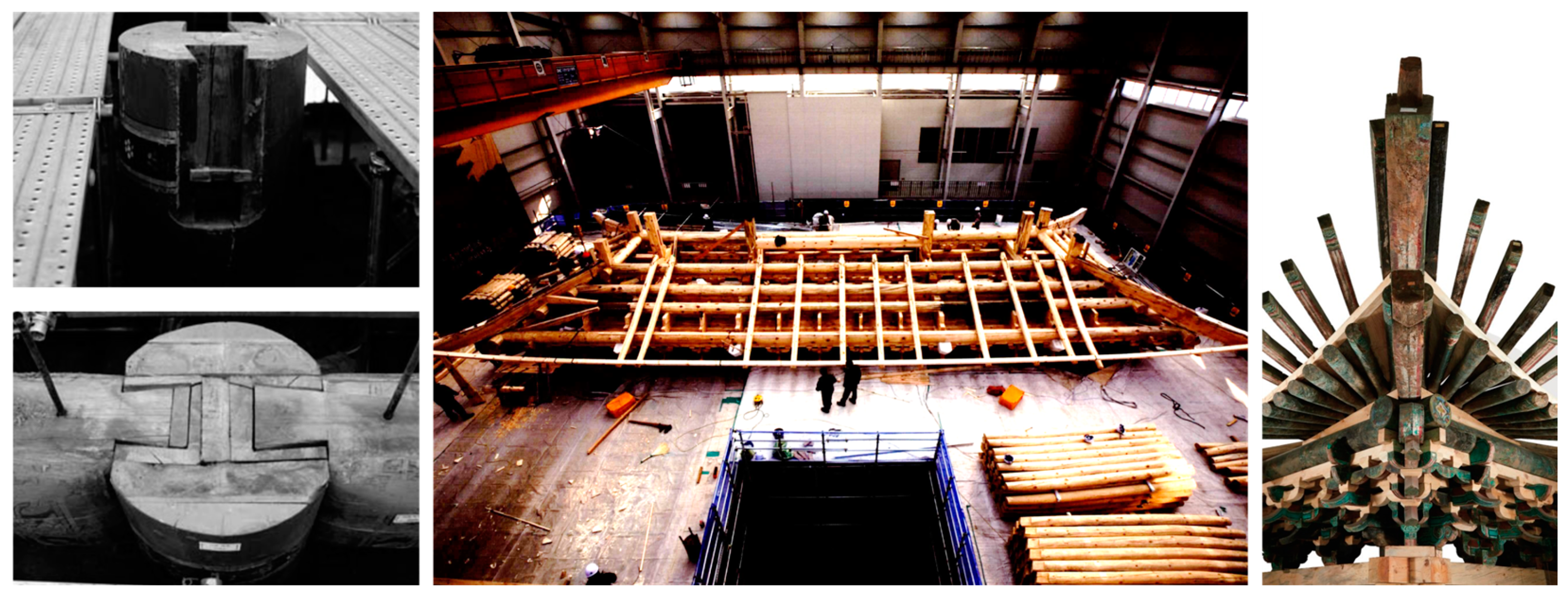
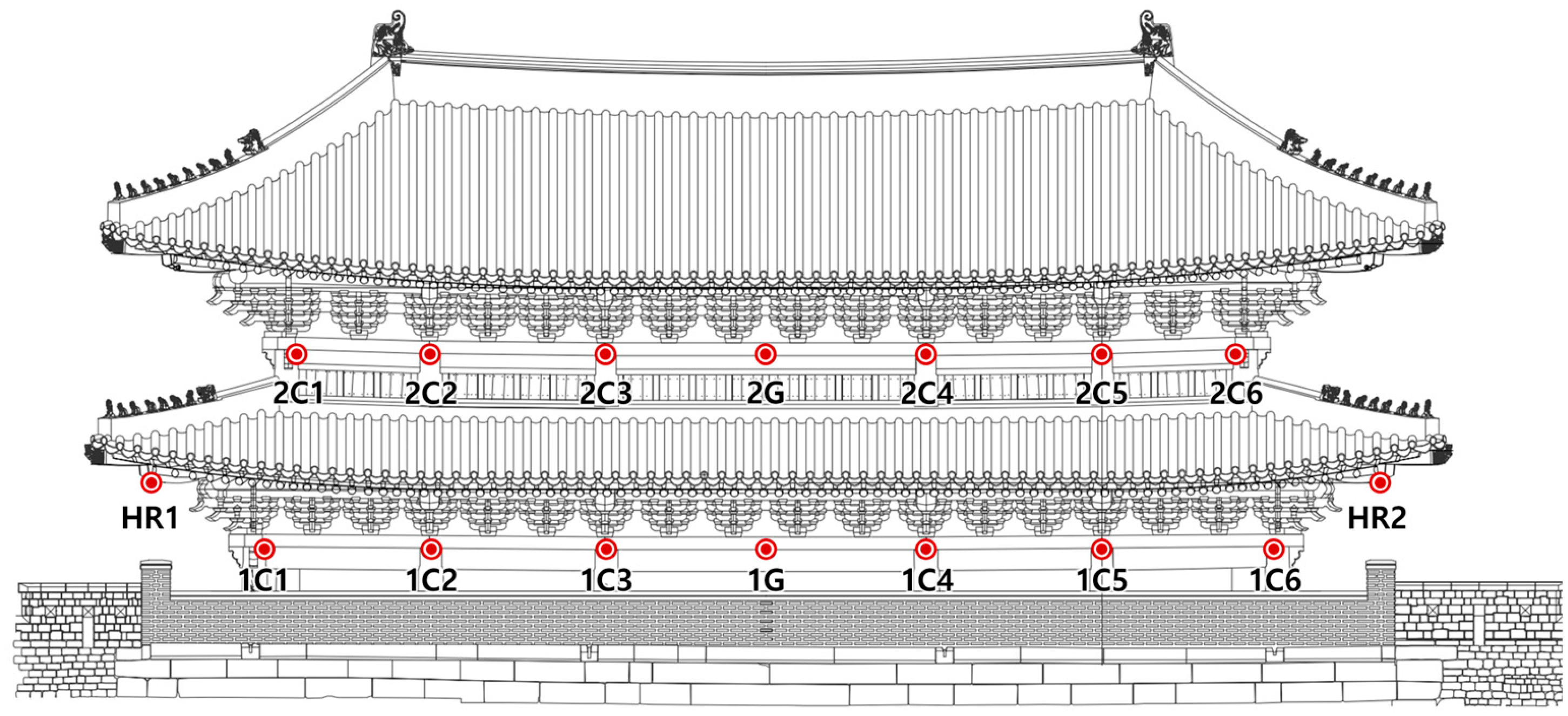
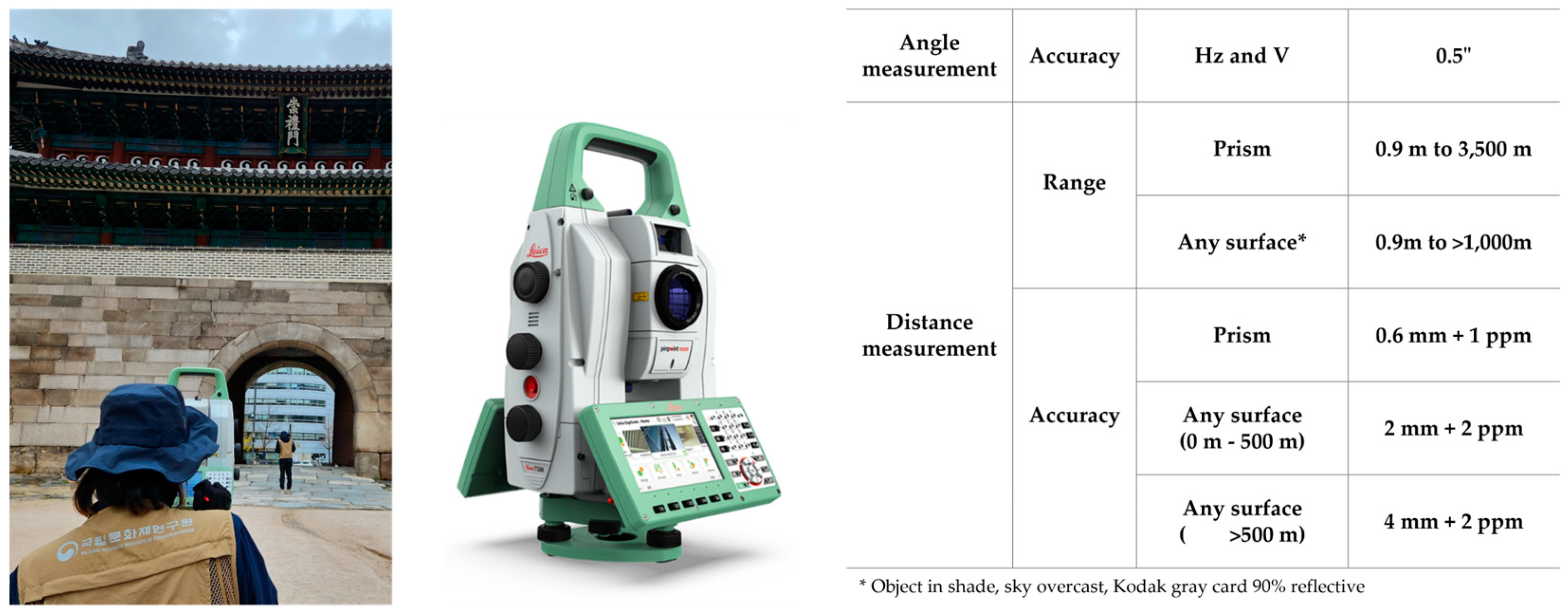
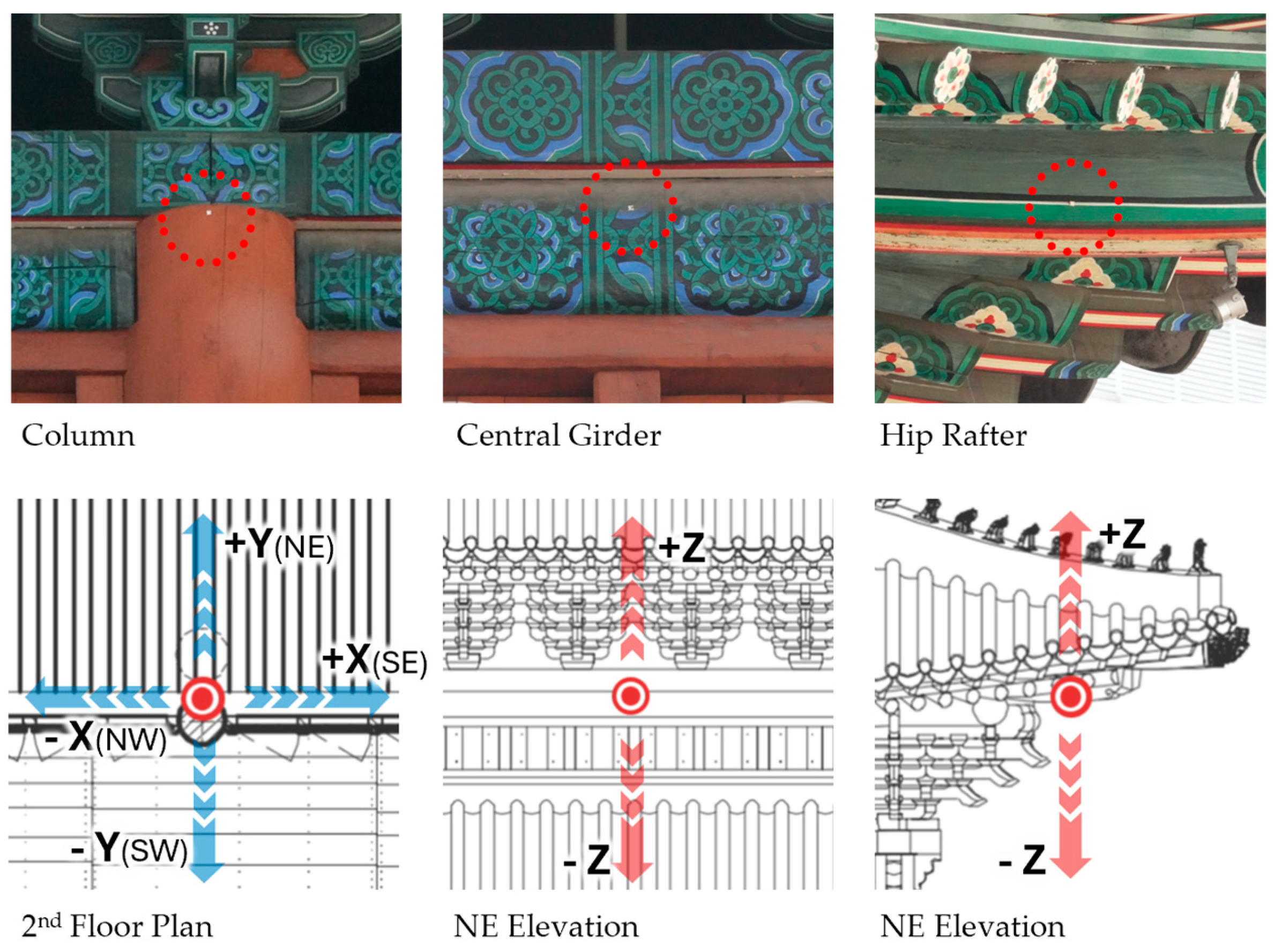
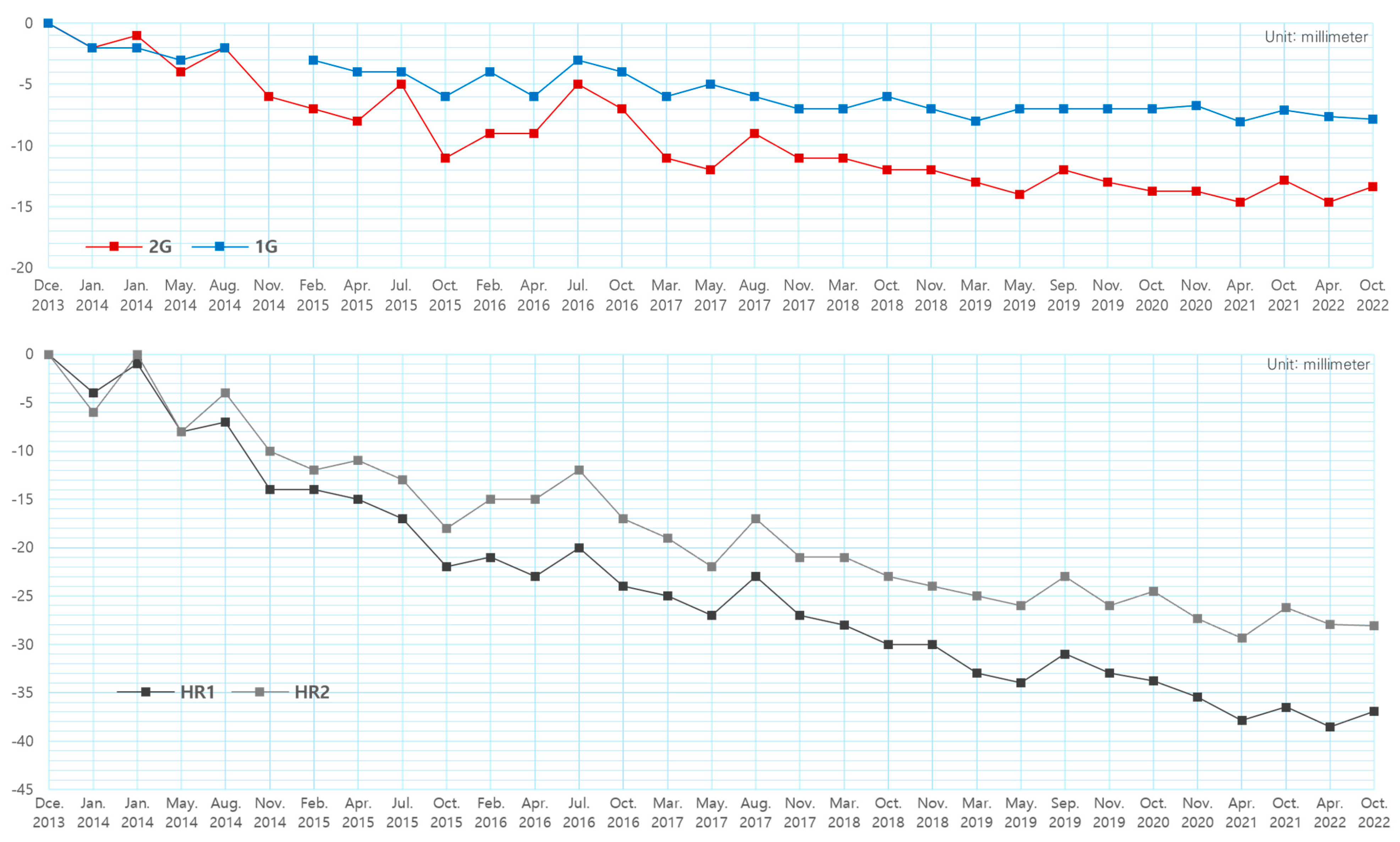
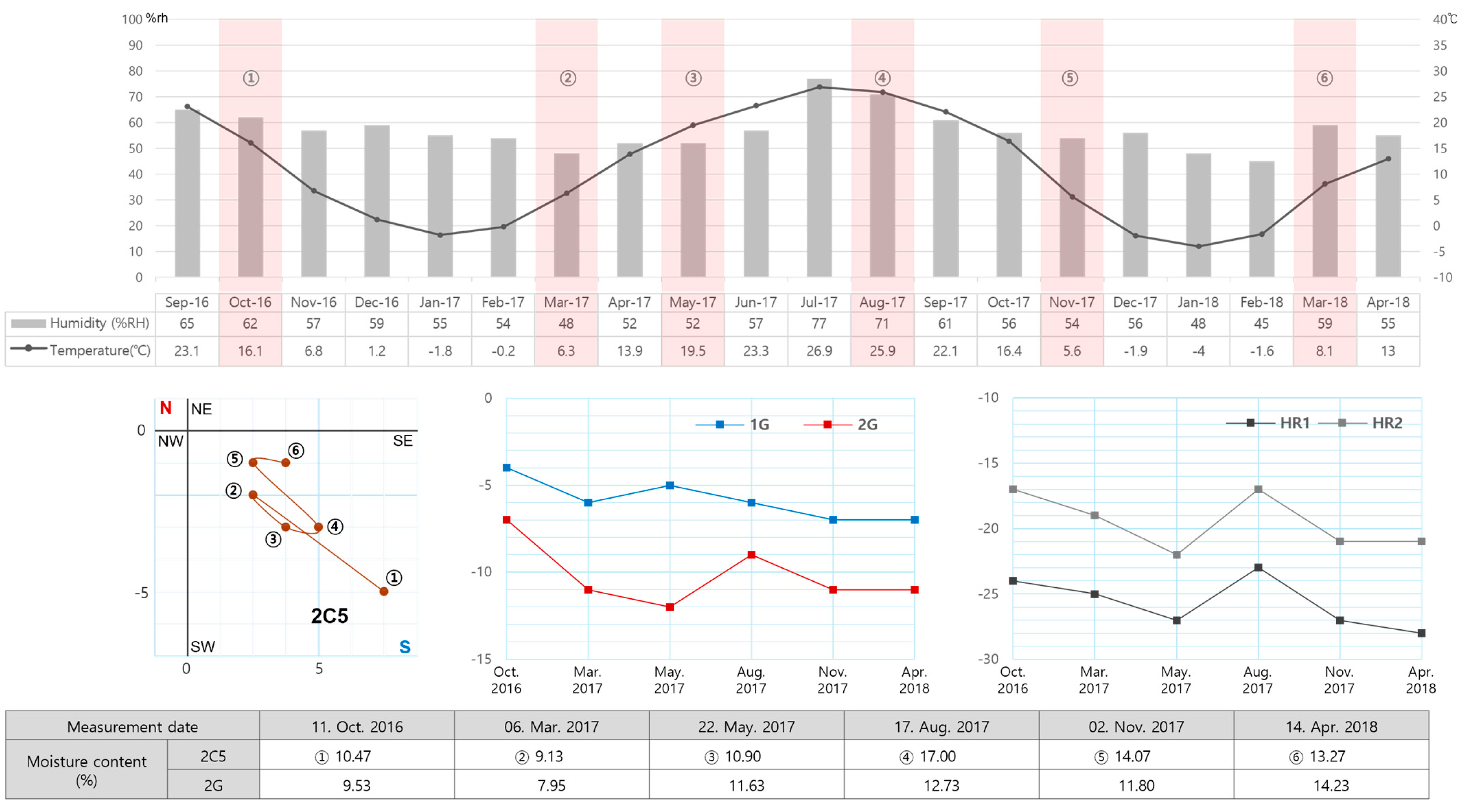
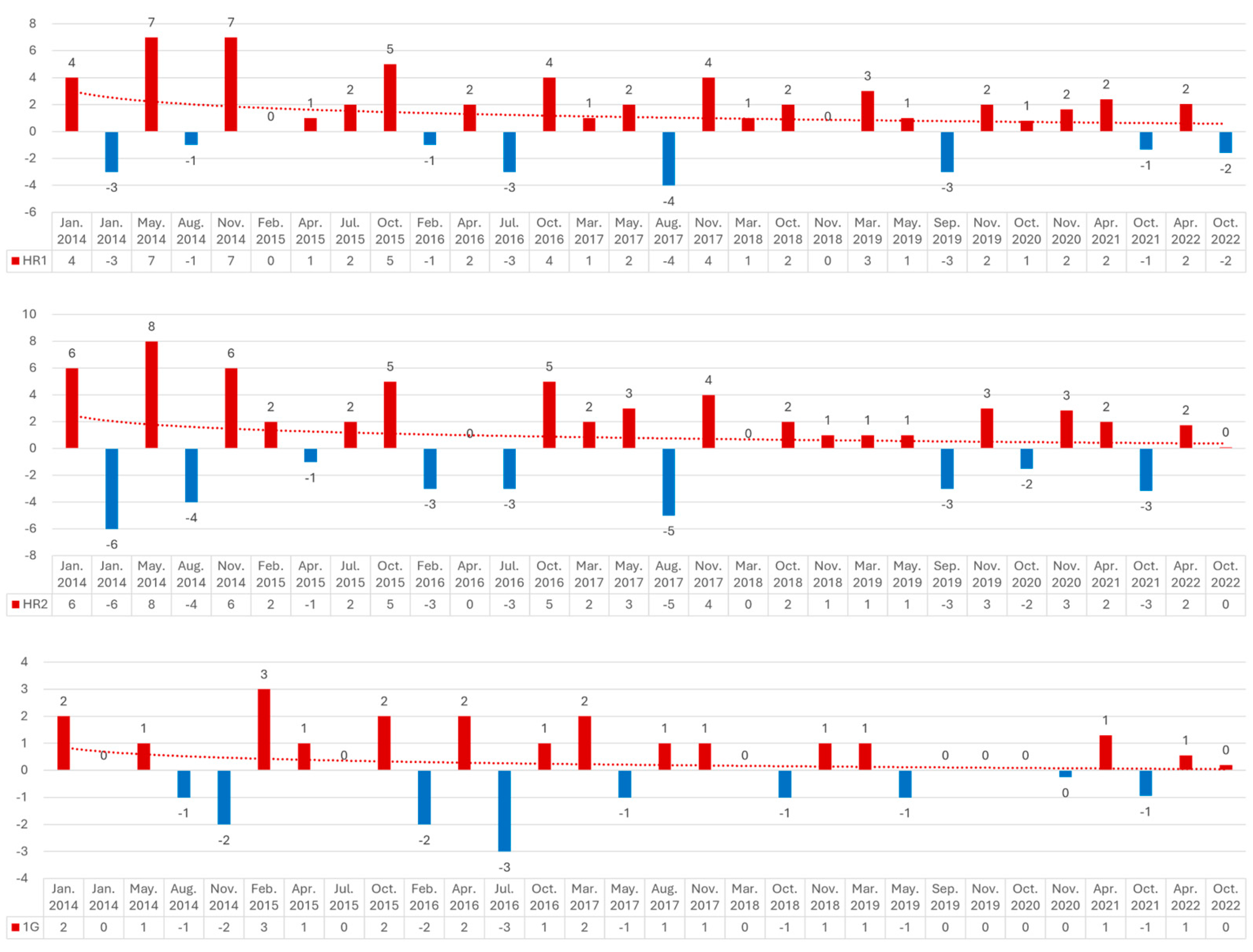
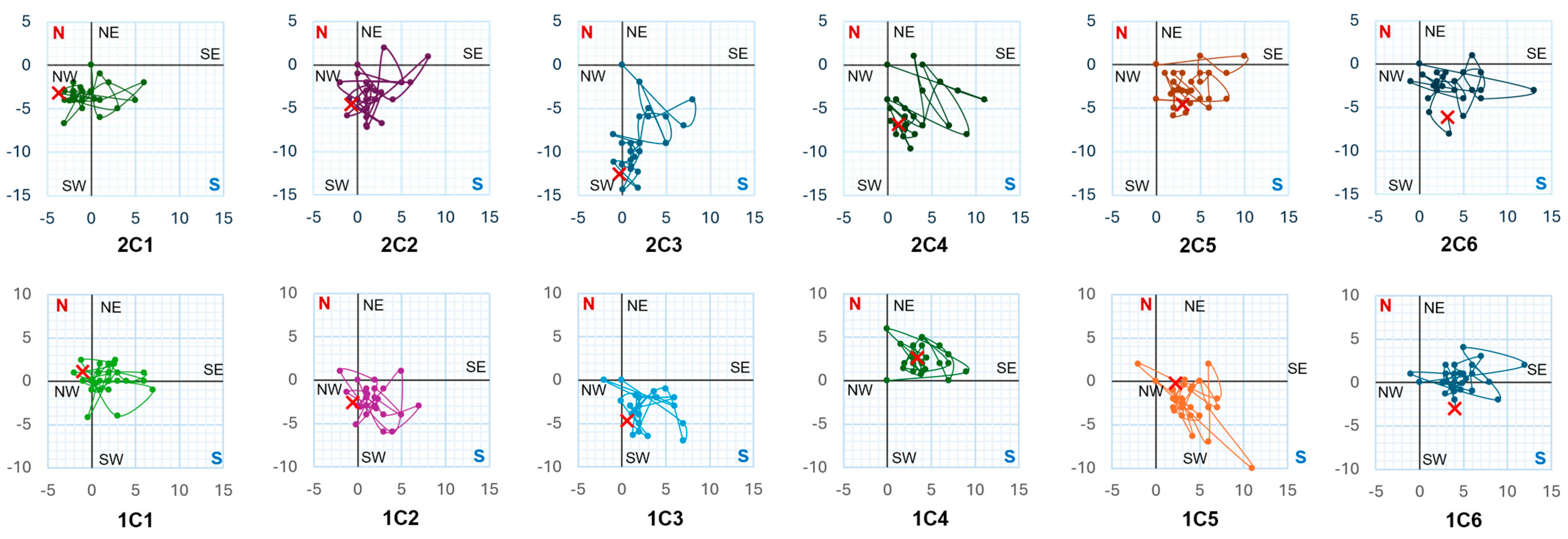

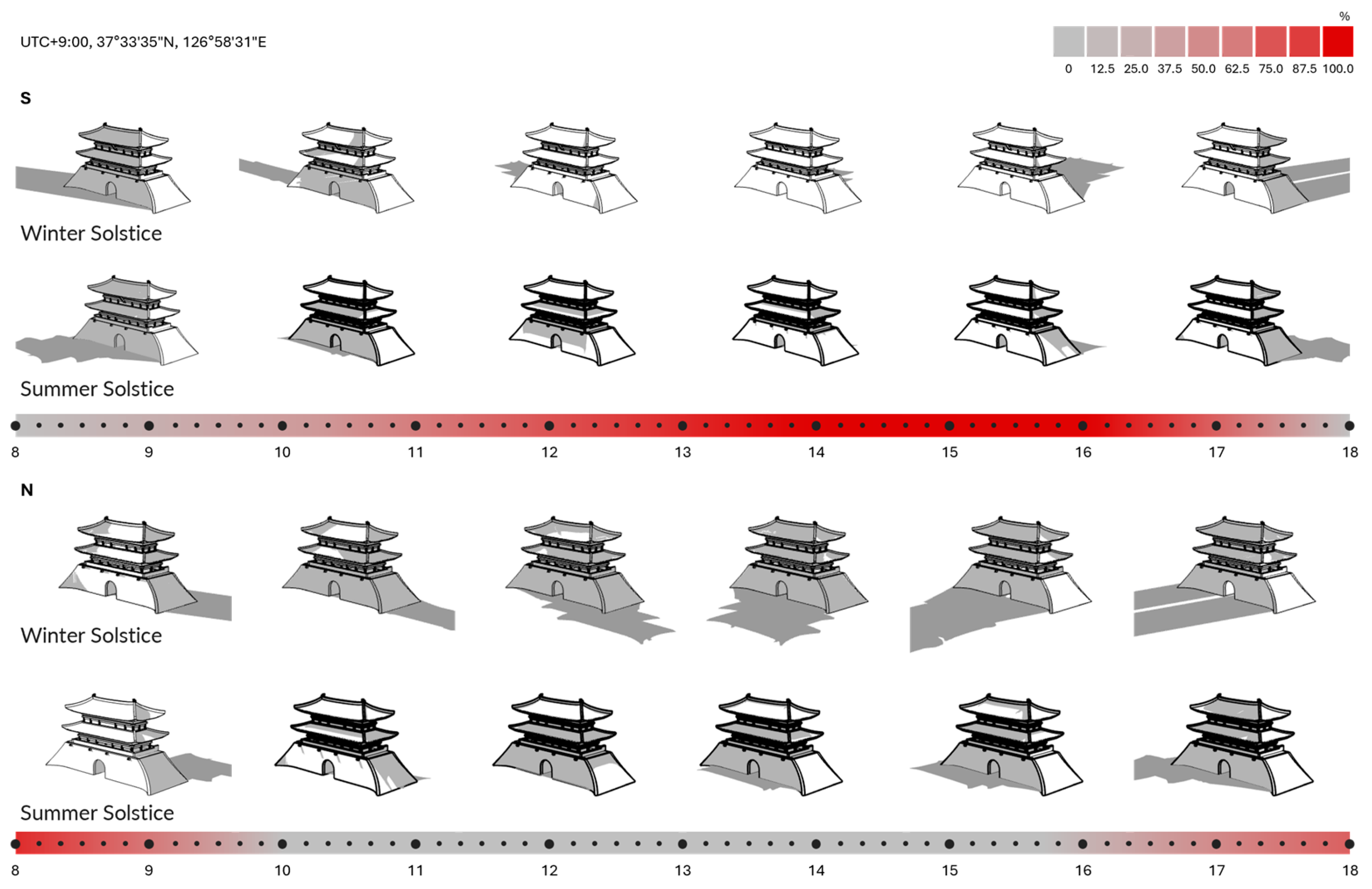
| No. | Date | Temperature (°C) | Relative Humidity (%) | Location |
|---|---|---|---|---|
| 1 | 18 December 2013 | −0.2 | 84 | 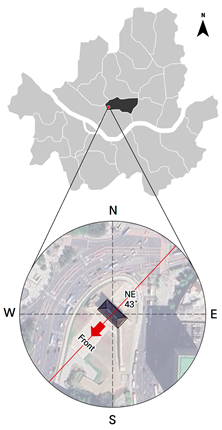 Seoul, Korea 37° 33′ 35″ N, 126° 58′ 31″ E |
| 2 | 16 January 2014 | 0.1 | 70 | |
| 3 | 27 January 2014 | 1.9 | 61 | |
| 4 | 22 May 2014 | 20.2 | 72 | |
| 5 | 13 August 2014 | 22.9 | 74 | |
| 6 | 18 November 2014 | 3.7 | 59 | |
| 7 | 5 February 2015 | −1 | 55 | |
| 8 | 22 April 2015 | 12.1 | 63 | |
| 9 | 14 July 2015 | 24.3 | 73 | |
| 10 | 14 October 2015 | 16.6 | 71 | |
| 11 | 3 February 2016 | −1.6 | 61 | |
| 12 | 18 April 2016 | 8.8 | 82 | |
| 13 | 19 July 2016 | 25.8 | 70 | |
| 14 | 11 October 2016 | 16.8 | 79 | |
| 15 | 6 March 2017 | −1 | 43 | |
| 16 | 22 May 2017 | 19 | 50 | |
| 17 | 17 August 2017 | 24.3 | 80 | |
| 18 | 02 November 2017 | 15 | 79 | |
| 19 | 14 March 2018 | 16.4 | 63 | |
| 20 | 1 October 2018 | 12.9 | 72 | |
| 21 | 26 November 2018 | 4.9 | 80 | |
| 22 | 5 March 2019 | 7.5 | 66 | |
| 23 | 21 May 2019 | 14.5 | 73 | |
| 24 | 23 September 2019 | 16.9 | 68 | |
| 25 | 12 November 2019 | 7.6 | 72 | |
| 26 | 12 October 2020 | 11.8 | 66 | |
| 27 | 11 November 2020 | 7.7 | 61 | |
| 28 | 14 April 2021 | 7.2 | 84 | |
| 29 | 18 October 2021 | 18.9 | 89 | |
| 30 | 11 April 2022 | 17.8 | 83 | |
| 31 | 12 October 2022 | 12.5 | 78 |
| 1F | 2F | |||||||||||||||||||||||||||
|---|---|---|---|---|---|---|---|---|---|---|---|---|---|---|---|---|---|---|---|---|---|---|---|---|---|---|---|---|
| 1C1 | 1C2 | 1C3 | 1C4 | 1C5 | 1C6 | 1G | HR1 | HR2 | 2C1 | 2C2 | 2C3 | 2C4 | 2C5 | 2C6 | 2G | |||||||||||||
| x | y | x | y | x | y | x | y | x | y | x | y | z | z | z | x | y | x | y | x | y | x | y | x | y | x | y | z | |
| Dec. 2013 | 0 | 0 | 0 | 0 | 0 | 0 | 0 | 0 | 0 | 0 | 0 | 0 | 0 | 0 | 0 | 0 | 0 | 0 | 0 | 0 | 0 | 0 | 0 | 0 | 0 | 0 | 0 | 0 |
| Jan. 2014 | 3 | −4 | 3 | −6 | 7 | −5 | 9 | 1 | 11 | −10 | 12 | 2 | −2 | −4 | −6 | 1 | −6 | 4 | −4 | 7 | −7 | 11 | −4 | 10 | 1 | 13 | −3 | −2 |
| Jan. 2014 | 7 | −1 | 7 | −3 | 7 | −7 | 7 | 3 | 6 | −3 | 5 | 4 | −2 | −1 | 0 | 6 | −2 | 8 | 1 | 8 | −4 | 8 | −3 | 8 | −1 | 7 | −4 | −1 |
| May. 2014 | 3 | 0 | 3 | −4 | 5 | −1 | 6 | 4 | 5 | 0 | 8 | 0 | −3 | −8 | −8 | 1 | −4 | 2 | −4 | 3 | −6 | 6 | −2 | 5 | 1 | 6 | −3 | −4 |
| Aug. 2014 | 0 | 0 | 2 | −1 | 2 | −3 | 4 | 5 | 4 | −1 | 6 | 1 | −2 | −7 | −4 | −2 | −4 | 0 | −1 | 2 | −2 | 4 | 0 | 5 | −2 | 5 | −1 | −2 |
| Nov. 2014 | 6 | 0 | 5 | −4 | 6 | −2 | 7 | 2 | 7 | −3 | 7 | 3 |  | −14 | −10 | 3 | −5 | 5 | −2 | 5 | −9 | 7 | −7 | 6 | −1 | 7 | −1 | −6 |
| Feb. 2015 | 3 | 1 | 2 | −2 | 4 | −2 | 4 | 1 | 5 | 0 | 4 | 2 | −3 | −14 | −12 | 1 | −1 | 3 | 2 | 3 | −5 | 4 | −3 | 5 | −1 | 5 | −6 | −7 |
| Apr. 2015 | 2 | 0 | 2 | −1 | 2 | −2 | 4 | 1 | 3 | −4 | 5 | 1 | −4 | −15 | −11 | 0 | −3 | 2 | −4 | 2 | −9 | 3 | 1 | 4 | −2 | 4 | −2 | −8 |
| Jul. 2015 | 1 | 0 | 2 | 0 | 2 | −2 | 4 | 2 | 5 | −4 | 4 | 1 | −4 | −17 | −13 | −3 | −4 | 0 | −4 | 2 | −9 | 4 | −7 | 5 | −4 | 5 | −4 | −5 |
| Oct. 2015 | −2 | 1 | −2 | 1 | −2 | 0 | 0 | 6 | −2 | 2 | −1 | 1 | −6 | −22 | −18 | −3 | −3 | −2 | −2 | −1 | −8 | 0 | −4 | 0 | −4 | −1 | −2 | −11 |
| Feb. 2016 | 6 | 1 | 4 | −6 | 6 | −3 | 7 | 3 | 7 | −2 | 9 | −2 | −4 | −21 | −15 | 5 | −4 | 6 | −2 | 5 | −9 | 9 | −8 | 8 | −4 | 7 | −3 | −9 |
| Apr. 2016 | 4 | 0 | 5 | 1 | 4 | −2 | 7 | 0 | 6 | 2 | 6 | 2 | −6 | −23 | −15 | 2 | −2 | 5 | −2 | 5 | −6 | 6 | −2 | 6 | −1 | 6 | 1 | −9 |
| Jul. 2016 | 2 | 2 | 3 | −1 | 2 | −2 | 6 | 2 | 6 | −7 | 6 | −1 | −3 | −20 | −12 | 0 | −3 | 1 | −2 | 2 | −6 | 4 | −7 | 6 | −4 | 5 | −1 | −5 |
| Oct. 2016 | 2 | 1 | 1 | −3 | 2 | −4 | 4 | 5 | 4 | −4 | 6 | −1 | −4 | −24 | −17 | 0 | −3 | 2 | −3 | 2 | −10 | 4 | −7 | 6 | −5 | 4 | −2 | −7 |
| Mar. 2017 | −1 | 0 | 0 | −3 | 1 | −3 | 2 | 2 | 2 | −1 | 3 | 0 | −6 | −25 | −19 | −1 | −4 | 1 | −3 | 1 | −9 | 1 | −4 | 2 | −2 | 2 | −2 | −11 |
| May. 2017 | 2 | −1 | 2 | −3 | 2 | −5 | 3 | 3 | 3 | −3 | 3 | 2 | −5 | −27 | −22 | −1 | −5 | 1 | −5 | 1 | −10 | 2 | −5 | 3 | −3 | 2 | −3 | −12 |
| Aug. 2017 | 0 | 0 | 1 | −2 | 2 | −2 | 4 | 1 | 4 | −3 | 4 | 0 | −6 | −23 | −17 | −2 | −3 | 0 | −4 | 1 | −9 | 3 | −6 | 4 | −3 | 4 | −3 | −9 |
| Nov. 2017 | 0 | 0 | 1 | −2 | 2 | −2 | 3 | 2 | 2 | −2 | 4 | −1 | −7 | −27 | −21 | −2 | −3 | 1 | −3 | 0 | −9 | 1 | −4 | 2 | −1 | 2 | −1 | −11 |
| Mar. 2018 | 0 | −1 | 0 | −3 | 2 | −2 | 4 | 4 | 3 | −2 | 4 | 2 | −7 | −28 | −21 | −1 | −3 | 1 | −6 | 2 | −9 | 3 | −6 | 3 | −1 | 3 | −1 | −11 |
| Oct. 2018 | 1 | −1 | 2 | −3 | 2 | −4 | 4 | 2 | 3 | −3 | 4 | −1 | −6 | −30 | −23 | −1 | −4 | 2 | −4 | 1 | −10 | 2 | −7 | 2 | −3 | 2 | −3 | −12 |
| Nov. 2018 | 2 | 2 | 1 | −2 | 2 | −2 | 3 | 4 | 3 | −3 | 3 | 1 | −7 | −30 | −24 | −2 | −4 | 1 | −4 | 1 | −10 | 2 | −6 | 1 | −1 | 2 | −3 | −12 |
| Mar. 2019 | 2 | 2 | 1 | −2 | 2 | −3 | 3 | 3 | 2 | −3 | 4 | −2 | −8 | −33 | −25 | −1 | −3 | 1 | −7 | 2 | −10 | 1 | −7 | 2 | −3 | 2 | −3 | −13 |
| May. 2019 | 2 | 0 | 1 | −4 | 2 | −5 | 3 | 1 | 3 | −4 | 4 | −3 | −7 | −34 | −26 | −1 | −4 | 1 | −7 | 1 | −12 | 1 | −8 | 2 | −5 | 1 | −4 | −14 |
| Sep. 2019 | 0 | −1 | 1 | −2 | 2 | −6 | 3 | 2 | 3 | −3 | 4 | −2 | −7 | −31 | −23 | −2 | −4 | 1 | −5 | 1 | −11 | 1 | −7 | 2 | −5 | 2 | −3 | −12 |
| Nov. 2019 | 1 | 2 | 1 | −1 | 2 | −4 | 3 | 3 | 2 | −2 | 3 | 1 | −7 | −33 | −26 | −2 | −2 | 1 | −4 | 1 | −10 | 1 | −7 | 2 | −3 | 2 | −3 | −13 |
| Oct. 2020 | 0 | 0 | 1 | −1 | 2 | −3 | 3 | 3 | 3 | 0 | 5 | 0 | −7 | −34 | −25 | −2 | −4 | −1 | −6 | 1 | −11 | 2 | −7 | 3 | −3 | 2 | −2 | −14 |
| Nov. 2020 | 1 | 1 | 0 | −3 | 1 | −4 | 3 | 3 | 2 | 0 | 4 | −1 | −7 | −35 | −27 | −2 | −4 | 1 | −5 | 0 | −11 | 0 | −7 | 2 | −3 | 0 | −1 | −14 |
| Apr. 2021 | 3 | 2 | 2 | −2 | 4 | −1 | 5 | 3 | 4 | −1 | 5 | 0 | −8 | −38 | −29 | 0 | −3 | 3 | −3 | 2 | −12 | 3 | −8 | 4 | −4 | 3 | −3 | −15 |
| Oct. 2021 | 0 | −4 | 0 | −5 | 1 | −6 | 2 | 4 | 2 | −3 | 3 | 0 | −7 | −37 | −26 | −3 | −7 | 1 | −7 | 0 | −14 | 2 | −8 | 3 | −3 | 2 | −3 | −13 |
| Apr. 2022 | 0 | 0 | 1 | −2 | 2 | −2 | 4 | 1 | 3 | 0 | 5 | 1 | −8 | −39 | −28 | −1 | −3 | 1 | −3 | 1 | −12 | 2 | −7 | 4 | −3 | 3 | −1 | −15 |
| Oct. 2022 | −1 | 2 | −1 | −1 | 0 | −2 | 2 | 1 | 2 | −2 | 3 | −1 | −8 | −37 | −28 | −3 | −3 | −1 | −4 | −1 | −11 | 0 | −5 | 2 | −6 | 1 | −6 | −13 |
Disclaimer/Publisher’s Note: The statements, opinions and data contained in all publications are solely those of the individual author(s) and contributor(s) and not of MDPI and/or the editor(s). MDPI and/or the editor(s) disclaim responsibility for any injury to people or property resulting from any ideas, methods, instructions or products referred to in the content. |
© 2025 by the authors. Licensee MDPI, Basel, Switzerland. This article is an open access article distributed under the terms and conditions of the Creative Commons Attribution (CC BY) license (https://creativecommons.org/licenses/by/4.0/).
Share and Cite
Seo, H.; Lee, H.; Kim, S. A Study of Member Displacement According to Seasonal Climate of the Sungnyemun Gate, a Korean Wooden Architectural Heritage Site. Buildings 2025, 15, 217. https://doi.org/10.3390/buildings15020217
Seo H, Lee H, Kim S. A Study of Member Displacement According to Seasonal Climate of the Sungnyemun Gate, a Korean Wooden Architectural Heritage Site. Buildings. 2025; 15(2):217. https://doi.org/10.3390/buildings15020217
Chicago/Turabian StyleSeo, Hyowon, Hana Lee, and Sunghan Kim. 2025. "A Study of Member Displacement According to Seasonal Climate of the Sungnyemun Gate, a Korean Wooden Architectural Heritage Site" Buildings 15, no. 2: 217. https://doi.org/10.3390/buildings15020217
APA StyleSeo, H., Lee, H., & Kim, S. (2025). A Study of Member Displacement According to Seasonal Climate of the Sungnyemun Gate, a Korean Wooden Architectural Heritage Site. Buildings, 15(2), 217. https://doi.org/10.3390/buildings15020217








